人称指示语的非常规用法
- 格式:pdf
- 大小:172.66 KB
- 文档页数:3
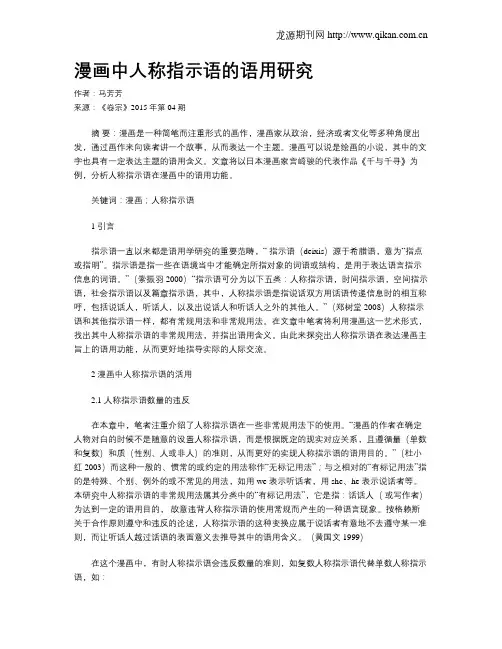
漫画中人称指示语的语用研究作者:马芳芳来源:《卷宗》2015年第04期摘要:漫画是一种简笔而注重形式的画作,漫画家从政治,经济或者文化等多种角度出发,通过画作来向读者讲一个故事,从而表达一个主题。
漫画可以说是绘画的小说,其中的文字也具有一定表达主题的语用含义。
文章将以日本漫画家宫崎骏的代表作品《千与千寻》为例,分析人称指示语在漫画中的语用功能。
关键词:漫画;人称指示语1 引言指示语一直以来都是语用学研究的重要范畴,“ 指示语(deixis)源于希腊语,意为“指点或指明”。
指示语是指一些在语境当中才能确定所指对象的词语或结构,是用于表达语言指示信息的词语。
”(索振羽 2000)“指示语可分为以下五类:人称指示语,时间指示语,空间指示语,社会指示语以及篇章指示语,其中,人称指示语是指说话双方用话语传递信息时的相互称呼,包括说话人,听话人,以及出说话人和听话人之外的其他人。
”(郑树堂 2008)人称指示语和其他指示语一样,都有常规用法和非常规用法。
在文章中笔者将利用漫画这一艺术形式,找出其中人称指示语的非常规用法,并指出语用含义。
由此来探究出人称指示语在表达漫画主旨上的语用功能,从而更好地指导实际的人际交流。
2 漫画中人称指示语的活用2.1 人称指示语数量的违反在本章中,笔者注重介绍了人称指示语在一些非常规用法下的使用。
“漫画的作者在确定人物对白的时候不是随意的设置人称指示语,而是根据既定的现实对应关系,且遵循量(单数和复数)和质(性别、人或非人)的准则,从而更好的实现人称指示语的语用目的。
”(杜小红 2003)而这种一般的、惯常的或约定的用法称作“无标记用法”;与之相对的“有标记用法”指的是特殊、个别、例外的或不常见的用法,如用 we 表示听话者,用 she、he 表示说话者等。
本研究中人称指示语的非常规用法属其分类中的“有标记用法”,它是指:话话人(或写作者)为达到一定的语用目的,故意违背人称指示语的使用常规而产生的一种语言现象。
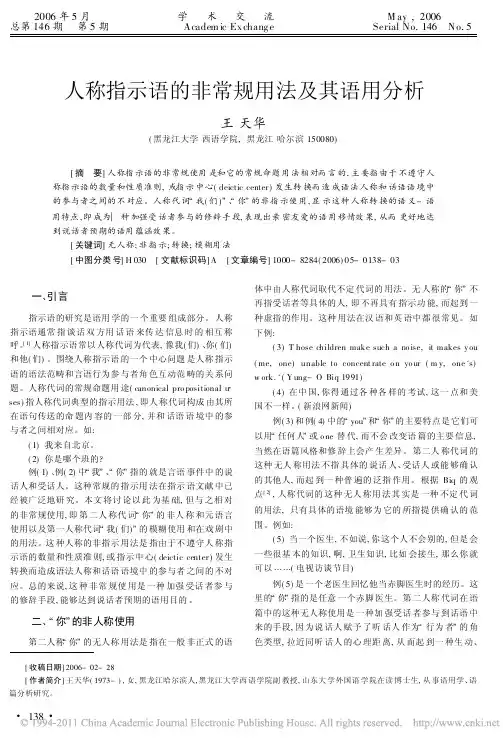
2006年5月 学 术 交 流 M ay ,2006总第146期 第5期 Academ ic Ex chang e Serial No.146 No.5[收稿日期]2006-02-28[作者简介]王天华(1973-),女,黑龙江哈尔滨人,黑龙江大学西语学院副教授,山东大学外国语学院在读博士生,从事语用学、语篇分析研究。
人称指示语的非常规用法及其语用分析王天华(黑龙江大学西语学院,黑龙江哈尔滨150080)[摘 要]人称指示语的非常规使用是和它的常规命题用法相对而言的,主要指由于不遵守人称指示语的数量和性质准则,或指示中心(deictic center )发生转换而造成语法人称和话语语境中的参与者之间的不对应。
人称代词 我(们) 、 你 的非指示使用,显示这种人称转换的语义-语用特点,即成为一种加强受话者参与的修辞手段,表现出亲密友爱的语用移情效果,从而更好地达到说话者预期的语用蕴涵效果。
[关键词]无人称;非指示;转换;模糊用法[中图分类号]H 030 [文献标识码]A [文章编号]1000-8284(2006)05-0138-03一、引言指示语的研究是语用学的一个重要组成部分。
人称指示语通常指谈话双方用话语来传达信息时的相互称呼。
[1]人称指示语常以人称代词为代表,像我(们)、你(们)和他(们)。
围绕人称指示语的一个中心问题是人称指示语的语法范畴和言语行为参与者角色互动范畴的关系问题。
人称代词的常规命题用途(canonical pro positional u ses)指人称代词典型的指示用法,即人称代词构成由其所在语句传送的命题内容的一部分,并和话语语境中的参与者之间相对应。
如:(1)我来自北京。
(2)你是哪个班的?例(1)、例(2)中 我 、 你 指的就是言语事件中的说话人和受话人。
这种常规的指示用法在指示语文献中已经被广泛地研究。
本文将讨论以此为基础,但与之相对的非常规使用,即第二人称代词 你 的非人称和元语言使用以及第一人称代词 我(们) 的模糊使用和在戏剧中的用法。
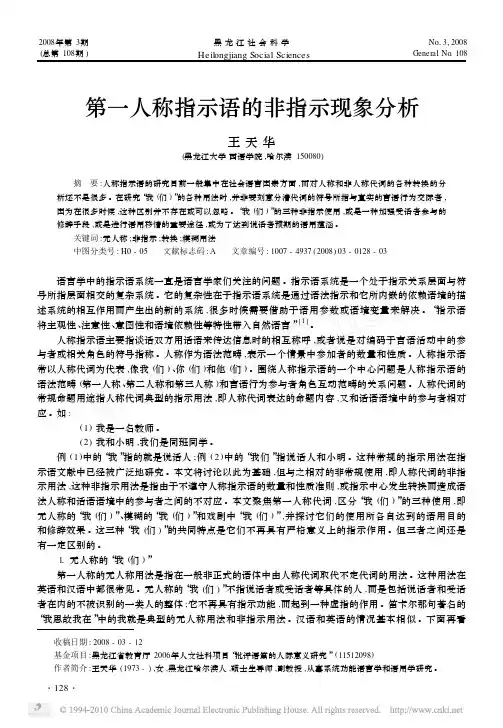
2008年第3期(总第108期)黑龙江社会科学Heil ongjiang Social Sciences No 13,2008General .No .108第一人称指示语的非指示现象分析王天华(黑龙江大学西语学院,哈尔滨150080)摘 要:人称指示语的研究目前一般集中在社会语言因素方面,而对人称和非人称代词的各种转换的分析还不是很多。
在研究“我(们)”的各种用法时,并非要刻意分清代词的符号所指与真实的言语行为交际者,因为在很多时候,这种区别并不存在或可以忽略。
“我(们)”的三种非指示使用,或是一种加强受话者参与的修辞手段,或是进行语用移情的重要途径,或为了达到说话者预期的语用蕴涵。
关键词:无人称;非指示;转换;模糊用法中图分类号:H0-05 文献标志码:A 文章编号:1007-4937(2008)03-0128-03收稿日期:2008-03-12基金项目:黑龙江省教育厅2006年人文社科项目“批评语篇的人际意义研究”(11512098)作者简介:王天华(1973-),女,黑龙江哈尔滨人,硕士生导师,副教授,从事系统功能语言学和语用学研究。
语言学中的指示语系统一直是语言学家们关注的问题。
指示语系统是一个处于指示关系层面与符号所指层面相交的复杂系统。
它的复杂性在于指示语系统是通过语法指示和它所内嵌的依赖语境的描述系统的相互作用而产生出的新的系统,很多时候需要借助于语用参数或语境变量来解决。
“指示语将主观性、注意性、意图性和语境依赖性等特性带入自然语言”[1]。
人称指示语主要指谈话双方用话语来传达信息时的相互称呼,或者说是对编码于言语活动中的参与者或相关角色的符号指称。
人称作为语法范畴,表示一个情景中参加者的数量和性质。
人称指示语常以人称代词为代表,像我(们)、你(们)和他(们)。
围绕人称指示语的一个中心问题是人称指示语的语法范畴(第一人称、第二人称和第三人称)和言语行为参与者角色互动范畴的关系问题。
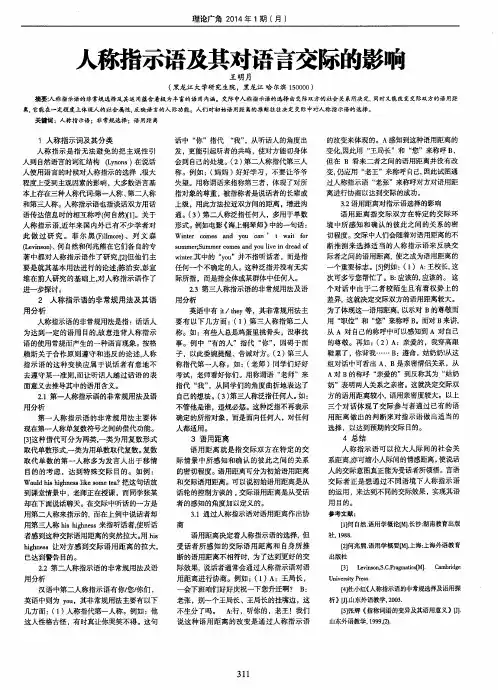
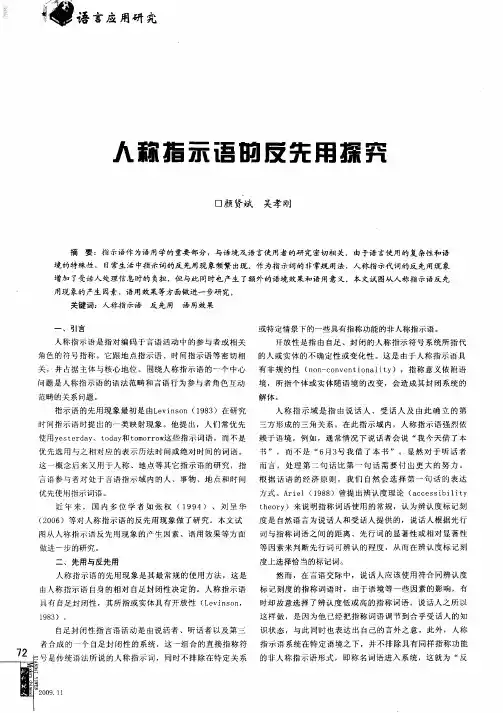
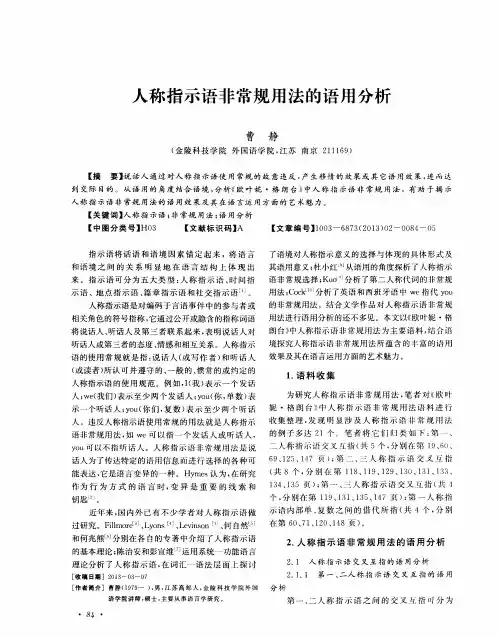
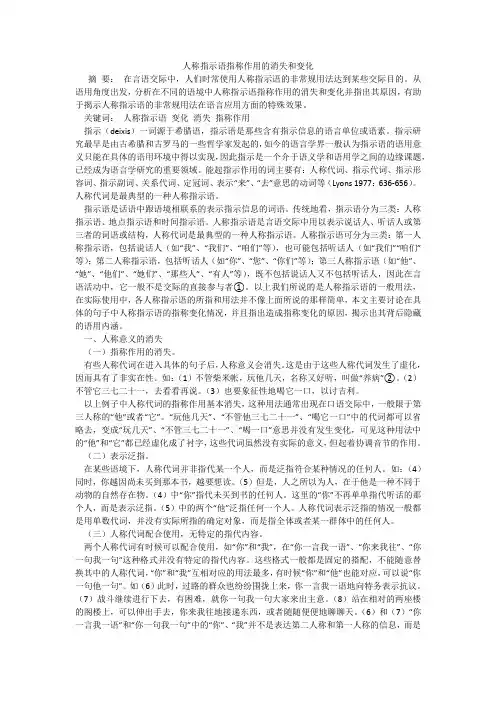
人称指示语指称作用的消失和变化摘要:在言语交际中,人们时常使用人称指示语的非常规用法达到某些交际目的。
从语用角度出发,分析在不同的语境中人称指示语指称作用的消失和变化并指出其原因,有助于揭示人称指示语的非常规用法在语言应用方面的特殊效果。
关键词:人称指示语变化消失指称作用指示(deixis)一词源于希腊语,指示语是那些含有指示信息的语言单位或语素。
指示研究最早是由古希腊和古罗马的一些哲学家发起的,如今的语言学界一般认为指示语的语用意义只能在具体的语用环境中得以实现,因此指示是一个介于语义学和语用学之间的边缘课题,已经成为语言学研究的重要领域。
能起指示作用的词主要有:人称代词、指示代词、指示形容词、指示副词、关系代词、定冠词、表示“来”、“去”意思的动词等(Lyons 1977:636-656)。
人称代词是最典型的一种人称指示语。
指示语是话语中跟语境相联系的表示指示信息的词语。
传统地看,指示语分为三类:人称指示语、地点指示语和时间指示语。
人称指示语是言语交际中用以表示说话人、听话人或第三者的词语或结构,人称代词是最典型的一种人称指示语。
人称指示语可分为三类:第一人称指示语,包括说话人(如“我”、“我们”、“咱们”等),也可能包括听话人(如“我们”“咱们”等);第二人称指示语,包括听话人(如“你”、“您”、“你们”等);第三人称指示语(如“他”、“她”、“他们”、“她们”、“那些人”、“有人”等),既不包括说话人又不包括听话人,因此在言语活动中,它一般不是交际的直接参与者①。
以上我们所说的是人称指示语的一般用法,在实际使用中,各人称指示语的所指和用法并不像上面所说的那样简单,本文主要讨论在具体的句子中人称指示语的指称变化情况,并且指出造成指称变化的原因,揭示出其背后隐藏的语用内涵。
一、人称意义的消失(一)指称作用的消失。
有些人称代词在进入具体的句子后,人称意义会消失。
这是由于这些人称代词发生了虚化,因而具有了非实在性。
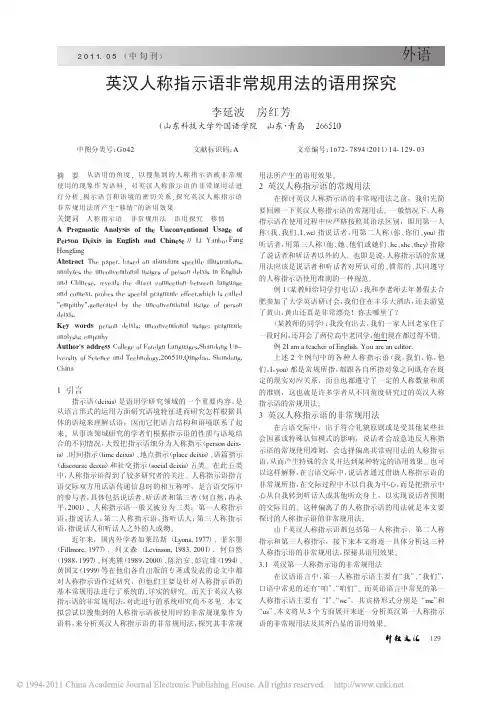
摘要从语用的角度,以搜集到的人称指示语被非常规使用的现象作为语料,对英汉人称指示语的非常规用法进行分析,揭示语言和语境的密切关系,探究英汉人称指示语非常规用法所产生“移情”的语用效果。
关键词人称指示语非常规用法语用探究移情A Pragmatic Analysis of the Unconventional Usage of Person Deixis in English and Chinese//Li Yanbo,Fang HongfangAbstract The paper,based on abundant specific illustrations, analyzes the unconventional usages of person deixis in English and Chinese,reveals the direct connection between language and context,probes the special pragmatic effect,which is called "empathy",generated by the unconventional usage of person deixis.Key words person deixis;unconventional usage;pragmatic analysis;empathyAuthor's address College of Foreign Languages,Shandong Un-iversity of Science and Technology,266510,Qingdao,Shandong, China1引言指示语(deixis)是语用学研究领域的一个重要内容,是从语言形式的运用方面研究语境特征进而研究怎样根据具体的语境来理解话语,因而它把语言结构和语境联系了起来。
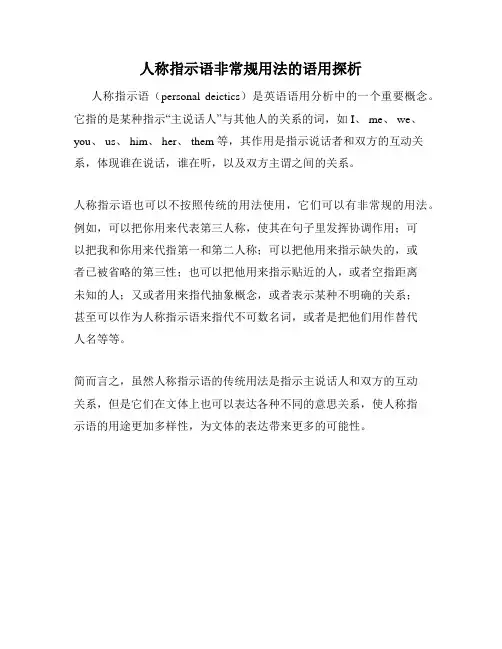
人称指示语非常规用法的语用探析
人称指示语(personal deictics)是英语语用分析中的一个重要概念。
它指的是某种指示“主说话人”与其他人的关系的词,如I、 me、 we、you、 us、 him、 her、 them 等,其作用是指示说话者和双方的互动关系,体现谁在说话,谁在听,以及双方主谓之间的关系。
人称指示语也可以不按照传统的用法使用,它们可以有非常规的用法。
例如,可以把你用来代表第三人称,使其在句子里发挥协调作用;可
以把我和你用来代指第一和第二人称;可以把他用来指示缺失的,或
者已被省略的第三性;也可以把他用来指示贴近的人,或者空指距离
未知的人;又或者用来指代抽象概念,或者表示某种不明确的关系;
甚至可以作为人称指示语来指代不可数名词,或者是把他们用作替代
人名等等。
简而言之,虽然人称指示语的传统用法是指示主说话人和双方的互动
关系,但是它们在文体上也可以表达各种不同的意思关系,使人称指
示语的用途更加多样性,为文体的表达带来更多的可能性。
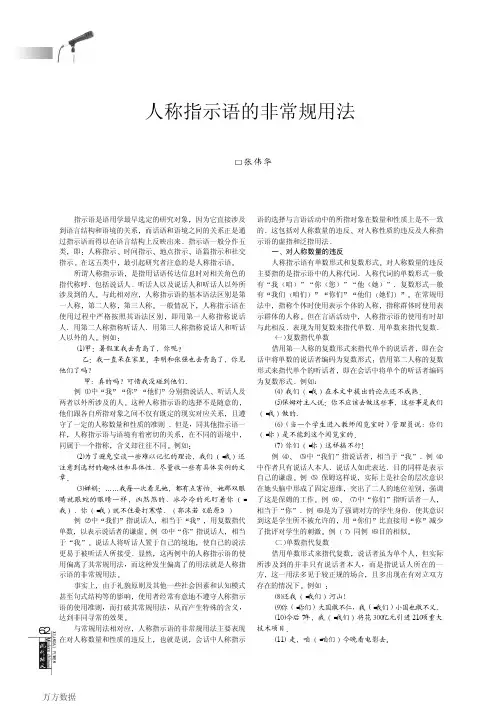
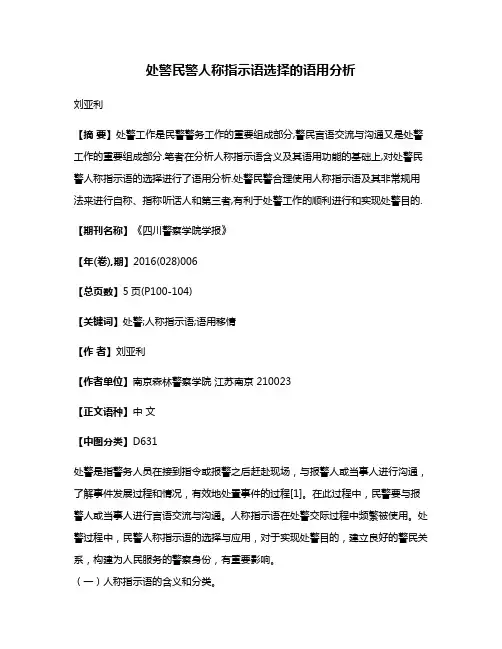
处警民警人称指示语选择的语用分析刘亚利【摘要】处警工作是民警警务工作的重要组成部分,警民言语交流与沟通又是处警工作的重要组成部分.笔者在分析人称指示语含义及其语用功能的基础上,对处警民警人称指示语的选择进行了语用分析.处警民警合理使用人称指示语及其非常规用法来进行自称、指称听话人和第三者,有利于处警工作的顺利进行和实现处警目的.【期刊名称】《四川警察学院学报》【年(卷),期】2016(028)006【总页数】5页(P100-104)【关键词】处警;人称指示语;语用移情【作者】刘亚利【作者单位】南京森林警察学院江苏南京 210023【正文语种】中文【中图分类】D631处警是指警务人员在接到指令或报警之后赶赴现场,与报警人或当事人进行沟通,了解事件发展过程和情况,有效地处置事件的过程[1]。
在此过程中,民警要与报警人或当事人进行言语交流与沟通。
人称指示语在处警交际过程中频繁被使用。
处警过程中,民警人称指示语的选择与应用,对于实现处警目的,建立良好的警民关系,构建为人民服务的警察身份,有重要影响。
(一)人称指示语的含义和分类。
人称指示语就是言语交际中用以表示说话人、听话人或第三者的词语或结构[2]。
大多数语言中的人称指示语都可分为三类,有单数和复数形式之别。
第一人称指示语,包括说话人(自称),例如汉语中的第一人称指示语“我”、“我们”,“咱”、“咱们”,英语中的I(me),we(us);也可能包括听话人,例如“我们”、“咱们”等;第二人称指示语包括听话人(对称),如汉语中的“你”、“你们”,英语中的you;第三人称指示语既不包括说话人也不包括听话人(他称),例如汉语中第三人称指示语“他”、“她”、“他们”、“它们”、“那人”、“这些人”、“有人”等,英语中第三人称指示语he/him,she/her,they/them,those people,that person,somebody等,多指说话人和听话人以外的第三者[2]。
人称指示语非常规用法的语用分析作者:江肖娜来源:《青年文学家》2016年第29期摘要:指示语是语用学研究的重要部分,指示语的运用则体现了语言使用对语言环境的依赖性,体现了语言结构和语境之间的密切关系。
人称指示语是指示语的一种,其使用也反映了人称指示与语言环境的密切关系。
本文拟从语用学的角度分析人称指示语在日常生活中的实际运用。
关键词:人称指示语;非常规用法;语用分析作者简介:江肖娜(1992-),女,汉族,山东省聊城人,辽宁大学研究生,研究方向:外国语言学及应用语言学。
[中图分类号]:H146 [文献标识码]:A[文章编号]:1002-2139(2016)-29--01一、引言在日常生活中,指示是一种普遍的语言现象。
指示语则是这一语言现象的具体体现,而指示语的应用必须依赖于特定的语境。
人称指示语是指示语的一种,指谈话双方用话语传递信息时所使用的称呼。
人称指示语包括三种:第一人称指示,第二人称指示,第三人称指示语。
在语用方面主要有两种用法:常规用法和非常规用法。
非常规用法必须依赖于一定的语境,因此必须结合特定的语境来进行话语分析。
二、第一人称指示语的非常规用法汉语中第一人称指示语主要有我/咱、我们/咱们,咱/咱们多用于口语中,英语中则有I/me、we/us。
其非常规用法主要有以下几个方面:(一)第一人称复数“我们”和“we”的用法汉语中的“我们”经常被用作第一人稱,目的在于表示说话者的谦逊、礼貌态度或者缩短同听话人之间的距离等等。
例如:1. 母亲对孩子说:我们该去上学了。
2. a doctor said to his patient:“how are we feeling today?”例1中母亲对孩子说话时使用“我们”而不是“我”,从而拉近了母亲与孩子的距离,体现了母子之间的亲近感。
例2表明英文中也存在相似的指示用法,为了表示对病人的关心,医生经常使用这样的人称指示语。
以上这两个例子从语用学角度属于语用移情。
文献综述《红楼梦》中第一人称指示语的非常规用法分析外语学院51110400038赵瑛瑛Analysis of the Unconventional Usage of the First Personal Deixis inA Dream of Red Mansions摘要:第一人称指示语,作为指示语的一个重要分支,在特定的话语中表达了人与人之间复杂的社交关系。
在中国古典名著《红楼梦》中,作者语言的娴熟运用以及小说人物关系的复杂性,是用来研究第一人称指示语必不可少的语料。
在具体话语中,第一人称指示语在特定“数”上发生的突变,即非常规用法,是本文研究的重点。
因此,本文主要对第一人称指示语“我”、“我们”、“咱们”在《红楼梦》中各种话语非常规用法的分析,并通过不同话语的语境来阐述第一人称指示语非常规用法对人物性格、地位等复杂关系的表现所起的重要作用。
关键词:第一人称指示语;红楼梦;非常规用法;社交关系Research Background:Deixis, as an important research subject in linguistics, is involved with the close connection between the utterance and the context. That is to say, in the particular context, the usage of deixis can demonstrate the relationship between the speaker and the addresser in an utterance. Deixis is often used in people‟ s utterances of daily life, for example, “Could you help me to carry it to that place? It is too heavy. ” In this utterance, deixis (“you”, “me”, “that”, “it”) refers to a person or a subject, but the addressee and speaker must be in the face-to-face interaction and the same context in which the addressee can easily understand the information that the speaker conveys. According to George Y ule (2000), deixis which derives from Greek is a technical term and it is one of the most fundamental things for people to deal with utterances. Also it means “pointing” and “indicating” throu gh language. S. C. Levinson (1983) has divided deixis into five forms: person deixis, place deixis, time deixis, discourse deixis, and social deixis.Person deixis is deictic reference of the participant role, including first person (…I‟, …we‟), second pe rson (…you‟), and third person (…he‟, …she‟, …it‟, and …they‟). In other words, person deixis consists of speaker, addressee, and other (s). It seems that the forms of person deixis are simple and limited, however, their complicated usage is hid behind. It can indicate people‟s social status,politeness, interpersonal relationship, and so forth.First person deixis, as an element of the person deixis, also indicates the interpersonal relationship and social status in terms of the addresser, the addressee and the third party involved in an utterance. There is an example about one of uses of the first person deixis: The final examination is coming, and the teacher says to the class, “We (= Y ou) should never give up, We (= Y ou) are the best!”In this utterance, the first person plural “we”refers to the second person “you”. It has a function that the teacher has the consideration for students that students are encouraged to try their best to get good grades. It‟s the unconventional usage of first person deixis, the study of which has been attached importance to by scholars and linguists. As is known to everyone, the significance of the first person deixis in linguistics is self-evident. It has become a normal phenomenon in people‟s daily life, and it exits in any kind of language. Although people use the first person deixis consistently, probably they cannot distinguish the concrete referring in the certain context. Generally, the unconventional usage of the person deixis plays an indispensible role in people‟s daily conversation. Thus, the study of this aspect can deeply manifest the diversity and complexity of the first person deixis, and also can be discovered in plenty of utterances in various famous novels both here and abroad.A Dream of Red Mansions, written in the latter half of the 18th century, has owns high fame in the literature of China, and even in the world. Cao Xueqin (1715-1763) is the author of this masterpiece. He was from a noble and powerful family, where he had realized the luxurious life of the noble families and ruling classes when he was a boy. However, because of his family declining from prosperity to poverty, he also had experienced the poor‟s miserable life when he was in an old age. It‟s an enormous contract to Cao Xueqin. And then he created the novel A Dream of Red Mansions, which is based on his own deep understanding of the extremely different life between the poor and the rich. Cao Xueqin perfectly make his idea --- brushing aside the aristocratic, sympathizing the poor people obviously through a great number of detailed descriptions of people‟s daily life. It also displays that Cao Xueqin‟s foresight for the equality. In A Dream of Red Mansions, there are all kinds of character roles, whose status, natures and social relationship are shown not only in their behaviors, but also in their utterances.The author, Cao Xueqin, makes full use of person deixis in various utterances to convey different social relationships, especially the use of the first person deixis. In this novel, there are anumber of utterances that can be analyzed into details. The utterances that employ the first person deixis create artistic effects and also portray the images and characteristics of the roles, which make the theme of the novel more profound. Taking A Dream of Red Mansions as language material to investigate the unconventional use can indicate the social complexity of the use of the first person deixis more obviously, and can make the research more specifically. The resent studies about person deixis have dispersed in different areas, including in semantics, pragmatics, sociolinguistics, comparative linguistics, etc. Furthermore, most of these studies focus on the first person deixis that is mostly related to the unconventional use. These previous researches will help the analysis of the first person deixis become more convincingly, and the study also can be propitious to people to use person deixis properly in daily conversation.Research Situation:During the past decades, the studies of person deixis, especially the first personal deixis, has been noticed by numerous scholars. The scholars‟ works and papers have focused on the research of person deixis in various fields and perspectives.Guan D eying‟s (2006) writing shows the pragmatics complexity of the personal deixis and the implicative meaning conveyed under the different contexts in terms of a contrastive analysis of the pragmatic differences and similarities between Chinese and English personal deixis. Guan suggests that the simple form of person deixis can not infer to the complex usage of it, and the study of person deixis should pay more attention to the specific context rather than restrict its use in grammar. In the case of the specific context, Feng Shubin and Liu Jiehui (2009) investigate the derivation of the context to the meaning of person deixis, and draw a conclusion that without the certain context, the texts or the utterances can be difficult to be understood. It means that the understanding of person deixis‟s meaning mostly depends on the context.The above studies mainly focus on person deixis in whole. There are also not a few papers about the first personal deixis, which is a branch of person deixis. It has implications in the utterances and texts as well. Lin Surong (2004) stresses on the different usages of the first personal deixis and the pragmatic connotation by relating to the context theory, the politeness phenomenon, the pragmatic empathy, and the speech act theory, aiming to understand and uselanguage much better. In the certain texts, Y ang a‟peng and Zhao Xueai (2009) claims that the uses of “we” can form a friendly relationship between the author and the reader in the texts, and attach importance to the interpers onal meaning of the usage of “we” instead of “I” or “you”. In addition, with regard to the study of the first person plural, Liu Liwu (2001) probes its referential meaning through the analysis of the usage of the exclusive “we” (speaker plus others(s), exc luding addressee) and the inclusive “we” (speaker and addressee included). At the same time, Liu points out the potential ambiguity in such uses. Guo qiping (2008) does research on it in the different aspect. Guo draws more attention to the deictic functio n of Chinese first personal pronouns “wǒ/ wǒmen”, which is applied to improving the dictionary definitions of “wǒ/ wǒmen”. Finally, Guo suggests that lexicographers should have a good knowledge of the pragmatic studies, and conduct the research of lexemes with the specific contexts.Nevertheless, besides these investigations, there are other perspectives on the pragmatic analysis of the first personal deixis, such as literature works, the language use in advertisements, politics and so on. Qian Bao (2009) describes that the first person singular used widely in Outlaw of the Marsh, consisting of both self-pronouns and self-titles. And Qian explains that the first person singular shows the roles‟ interrelationship and the difference of the power status betw een addressees and speakers, which represents the diversity of Chinese in this novel. To the probe of the first person deixis on English poems, Zhu Yitong and Liu Peng‟s (2008) paper is about the assay of the reason why the first personal deixis is made prominent in the poems through the appreciation of some poems‟ texts. The intercultural reading is necessary to truly comprehend poems in their paper. Huang Chunlan (2009) takes the language use in advertisements as an example to discuss deeply the deictic function of the first personal deixis in advertising texts. Huang holds that the wide use of it can create an interactive atmosphere, which provides potential customers with a sense of affability. Hence, customers can be stimulated to purchase more, and the advertising texts‟ persuasion is strengthened. At the same time, Huang proves the different usages and effects of the first personal deixis both in the advertising and daily communication. What‟s more, Wang Lidan (2009) reveals that the first personal deixis plays a role in building the power and identity of orators and audiences‟ position. The paper also examines the political power of the language.Researches that are mentioned above still may not be absolute. There is another field, which isthe conventional and unconventional usage of person deixis. The former means the respect to the categories of person deixis, while the latter flouts the maxims of the quality and quantity of person deixis, or the deictic center has been changed. The unconventional usage has been attached more importance to, especially in the first personal deixis. In fact, the above investigations have partly involved the unconventional usage, but they are not systemic. According to Hong Mudan (2008), the unconventional usage of the f irst personal deixis contains several aspects, including “I/zan” referring to “we/zan men”, “we” referring to “I”, and “we” referring to “you”, etc. Hong mentions that this usage exemplifies the pragmatic function of the politeness principles, the pragmatic empathy, the authority and the equality. The pragmatic empathy is more concerned by Qi Chao (2008). There is a phenomenon that speakers prefer to change the deictic center onto addressees so as to achieve the interpersonal purpose, which is called deictic projection by Lyons (1977). Qi takes advantage of the pragmatic empathy to explain the deictic projection, which infers that the first personal deixis can not be overlooked in the social occasions, and reflects the communicators‟ emotion and attitudes. Therefore, the study of the unconventional usage of the first personal deixis appears to be very important in pragmatics. Moreover, the research of the usage of the non-deixis is noticed by Wang Tianhua (2008). Wang divides it into three parts: the impersonal pronouns of “I/we”, the ambiguity of “I/we”, and “I/we” in dramas. Wang‟s paper indicates that the three parts of the non-deixis strengthen rhetoric figures of the participants, and show the intimate relationship by the choices of the empathy. In litera ture, Y an Junyu and Du Xiaohong‟s (2008) paper highlights the pragmatic function and the artistic effect of unconventional employments of the first personal deixis by a study of the unconventional use of the first personal deixis in the Scarlet Letter. Thus, pragmatic analysis of person deixis is extensively followed with interest and examined by numerous scholars and linguists. A Dream of Red Mansions, as one of the most prominent novels, is regarded as classic materials to study person deixis. Chen Li and Sun Chenrong (2008) illustrate A Dream of Red Mansions to approach the pragmatic function of the first personal deixis. Lu Shuxiang (1985) quotes many example sentences in A Dream of Red Mansions to elaborate person deixis in respect of the grammar. However, there is no systemic study of the unconventional usage of the first personal deixis to A Dream of Mansions. This paper concentrates on analysis of the unconventional usage of the first personal deixis in A Dream of Red Mansions. It aims to reveal the changes of the implications of the first personal deixis, and its different functions on portraysof different characters in the particular contexts.参考文献[1] George Y ule, 2000. Pragmatics. Shanghai: Shanghai Foreign Language Education Press.[2]Levinson, Stephen C, 1983. Pragmatics [M]. Cambridge, England: Cambridge UniversityPress.[3] John Lyons, 1977. Linguistic Semantics: An introduction [M]. Cambridge University Press.[4] 关德英,2006,人称指示在汉语、英语中的语用对比分析[J],《河北理工大学学报》第6卷第4期[5] 冯书彬,刘杰辉,2009, 英语语境对人称指示语的意义推导[J],《辽宁工业大学学报》第11卷第4期[6] 林素蓉,2004,第一人称指示语的语用分析[J],《山东教育学院学报》第1期[7] 杨阿鹏、赵雪爱,2009,第一人称复数指称对象的模糊性及其在语篇中的多重人际意义[J],《Science & Technology Information》第1期[8] 刘立吾,2001,论英语中第一人称复数的指示意义——兼论let‟s和let us句式中人称歧义[J],《湖南教育学院学报》第19卷第2期[9] 郭启平,2008,“我/我们”的人称指示功能及其对词典释义的启示[J],《西南科技大学学报》第25卷第1期[10] 钱宝,2009,水浒传第一人称单数指示语初探[J],《德州学院学报》第25卷第1期[11] 朱一童、刘鹏,2008,英文诗歌中第一人称指示词突显的原因解析[J],《内肛科技》第6期[12] 黄春兰,2009,广告语中第一和第二人称代词的语用指示功能[J],《安徽理工大学学报》第11卷第3期[13] 吴丽丹,2009,政治语篇中人称指示语的功能分析[J],《湖北大学成人教育学院学报》第27卷第4期[14] 洪牡丹,2008,浅议第一人称指示语非常规用法及其语用功能[J],《滁州学院学报》第10卷第4期[15] 齐超,2008,语用移情与离情——浅谈日常交往过程中人称指示语的选择[J],《读与写杂志》第5卷第7期[16] 王天华,2008,第一人称指示语的非指示现象分析[J],《黑龙江社会科学》第3期[17] 闫俊宇、杜小红,2008,《红字》中人称指示语非常规用法的语用分析[J],《郑州大学学报》第41卷第6期[18] 陈丽、孙承荣,2008,以《红楼梦》为例分析第一人称复数指示语的语用功能[J],《辽宁行政学院学报》第10卷第2期[19] 吕叔湘,1985,《近代汉语指代词》[J],学林出版社。
人称指示语的反先用探究指示语作为语用学的重要部分,与语境及语言使用者的研究密切相关。
由于语言使用的复杂性和语境的特殊性,日常生活中指示词的反先用现象频繁出现。
作为指示词的非常规用法,人称指示代词的反先用现象增加了受话人处理信息时的负担,但与此同时也产生了额外的语境效果和语用意义。
本文试图从人称指示语反先用现象的产生因素、语用效果等方面做进一步研究。
标签:人称指示语反先用语用效果一、引言人称指示语是指对编码于言语活动中的参与者或相关角色的符号指称。
它跟地点指示语、时间指示语等密切相关,并占据主体与核心地位。
围绕人称指示语的一个中心问题是人称指示语的语法范畴和言语行为参与者角色互动范畴的关系问题。
指示语的先用现象最初是由Levinson(1983)在研究时间指示语时提出的一类映射现象。
他提出,人们常优先使用yesterday、today和tomorrow这些指示词语,而不是优先选用与之相对应的表示历法时间或绝对时间的词语。
这一概念后来又用于人称、地点等其它指示语的研究,指言语参与者对处于言语指示域内的人、事物、地点和时间优先使用指示词语。
近年来,国内多位学者如张权(1994)、刘呈华(2006)等对人称指示语的反先用现象做了研究。
本文试图从人称指示语反先用现象的产生因素、语用效果等方面做进一步的研究。
二、先用与反先用人称指示语的先用现象是其最常规的使用方法,这是由人称指示语自身的相对自足封闭性决定的。
人称指示语具有自足封闭性,其所指或实体具有开放性(Levinson,1983)。
自足封闭性指言语活动是由说活者、听话者以及第三者合成的一个自足封闭性的系统,这一组合的直接指称符号是传统语法所说的人称指示词,同时不排除在特定关系或特定情景下的一些具有指称功能的非人称指示语。
开放性是指由自足、封闭的人称指示符号系统所指代的人或实体的不确定性或变化性。
这是由于人称指示语具有非规约性(non-conventionality),指称意义依附语境,所指个体或实体随语境的改变,会造成其封闭系统的解体。
第二人称指示语的非常规指示及其语用分析--略谈其在恩施方言中的应用龙在波【摘要】人称代词除了常规的指示用法,也存在着一些非常规用法,这主要是指由于不遵守人称指示语的数量或性质准则,或指示中心发生转换而造成的语法人称和话语环境中的参与者之间的不对应。
而分析并正确使用人称指示语的非常规指示用法,有助于我们更好地利用语言这门工具达到交际的效果和目的。
【期刊名称】《太原城市职业技术学院学报》【年(卷),期】2014(000)002【总页数】2页(P197-198)【关键词】第二人称指示语;非常规用法;恩施方言【作者】龙在波【作者单位】长江大学工程技术学院,湖北荆州 434023【正文语种】中文【中图分类】H17人称指示语是通过公开或隐含的人称代词把话语中的人或物与说话者、听话者或第三者联系起来,表明彼此关系。
而在使用语言的时候,为了达到一定的交际目的或交际效果,说话者通常都会使用人称指示语的非常规用法。
本文选取人称指示语中的第二人称指示语为例,探讨其在恩施方言中的运用,并对其社交语用内涵进行分析,从而促进对语言使用多样性的研究,推动语言科学不断发展。
汉语第二人称指示语不仅包括你、你们,还包括您。
而后者,通常表示对年长者或职位比自己高的人的敬称。
同时,这一类词也应用于正式场合对不熟悉的人的尊称。
恩施方言中对第二人称指示语范畴的规定也与之一致。
在无特殊语用情景的条件下,第二人称指示语的使用均遵守语法规则,即指听话人,这种用法即第二人称的常规用法。
例:(1)你咧个嫌人娃(儿)!你这个淘气的孩子!(2)您(儿)这们大年纪哒,国人好神点儿!您这么大年纪了,做事情都小心点!以上两例都是恩施方言中第二人称的常规用法。
(1)中是长者对小孩子常说的话,其中的“你”即指话语传达的对象——孩子。
例(2)中,由于话语参与者变成了说话者的年长者,出于礼貌,说话者用“您”代替“你”。
其中的“您”指代听话的一位老年人以上对第二人称指示语的使用,都严格遵守了人称指示语的分类并与现实所指目标之间有着严格的对应关系,属于第二人称指示语的常规指示用法。